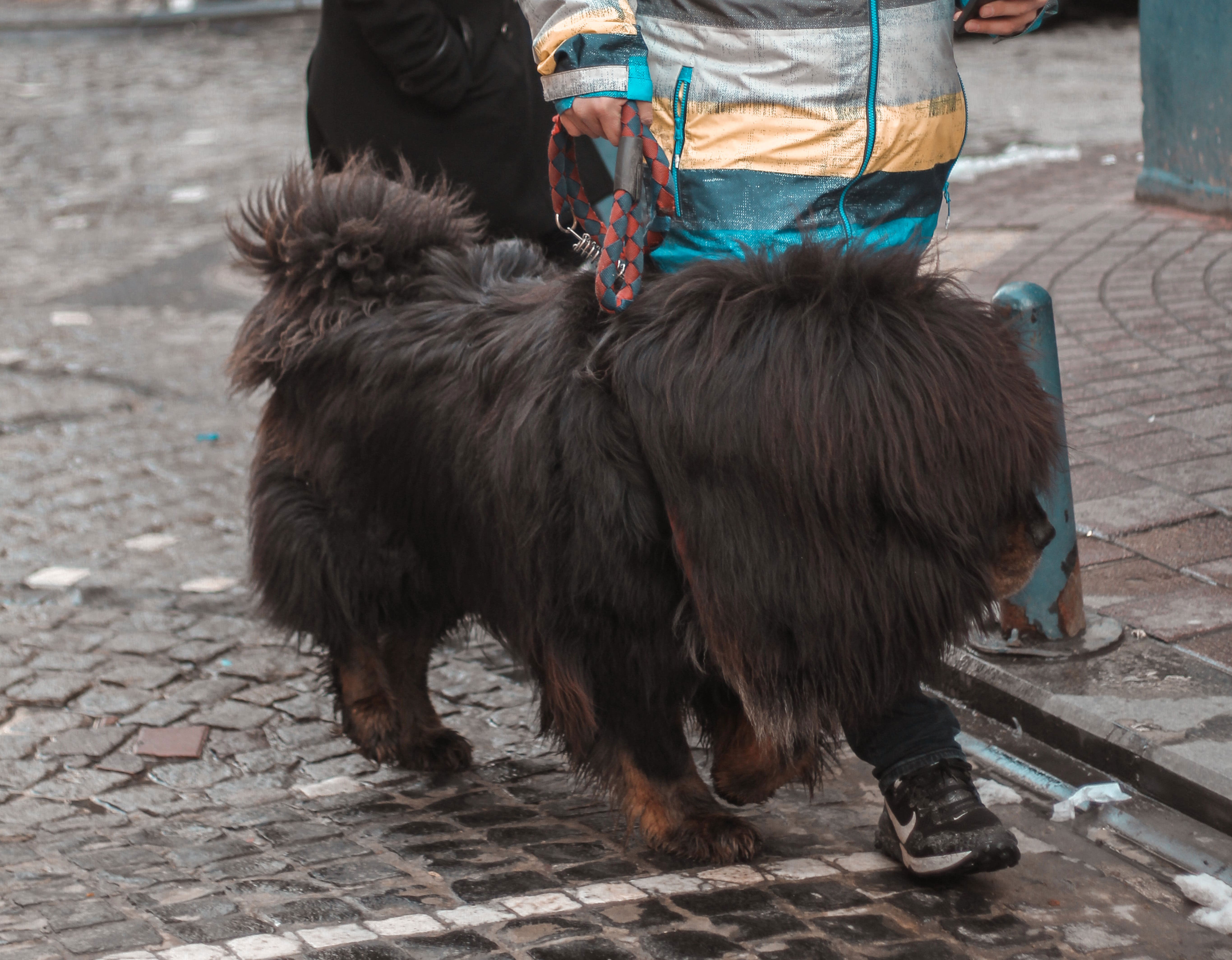If you’re considering bringing a canine companion into your home, you might want to consider the Tibetan Mastiff dog breed. With their majestic coat, independent nature, and natural instinct to protect their territory, Tibetan Mastiffs are fascinating animals that require specific care and attention.
In this article, we’ll cover everything you need to know about this ancient breed, including origin, temperament, grooming needs, training tips, and health concerns. Whether you’re a new pet parent or an experienced one, learn what it takes to provide the best possible environment for your Tibetan Mastiff.
- Tibetan Mastiffs are ancient, protective, and once guarded Tibetan monks.
- Males can weigh up to 160 pounds, females up to 110 pounds.
- They have a thick double coat and require regular grooming.
- Early socialization and training are vital for their temperament.
- Common health issues include dysplasia and Hypothyroidism.
The information provided herein is for informational purposes only. Please refer to our disclaimer for more details..
Interesting Facts:
Origin: Tibetan Mastiffs are an ancient breed with a rich history and origin in Tibet. Known for guarding Monks in the Himalayan mountains of Tibet.
Temperament: They’re known for their aloofness, loyalty, and protective nature, making this breed the best dog for guarding families.
Size: A large dog breed with giant built, males stand at an avg. height of 26 inches and females slightly shorter at 24 inches. Males Weigh at 90 to 160 pounds and females weigh at around 70 to 110 pounds.
Appearance: An impressive feature that adds to the appearance is its lion mane, thick long hairs covering the forehead till withers, covering the neck and shoulders. This adds up to the humongous stature with muscular build. Ears are large and droopy forms a V shape, head is broad.
Tibetan Mastiff puppies: weigh about 5 to 10 pounds when a pup reaches one month of age.
Coat: Thick double coat with medium or long length that comes in a variety of colors like: Black, Brown, Cream Sable, Black and Tan, Red gold, cream, Brown and Tan. Often has white markings on the coat.
Grooming needs: include a thick undercoat that requires regular brushing and dental care, while a balanced diet is essential in maintaining their weight and overall health.
Agility: despite the large size, this breed is known for its agility, can run at a speed of 30 to 32km /hour for a short distance.
Exercise needs: Moderate
Lifespan: 10 to 14 years.
Health Issues: some of the common health issues are elbow and hip dysplasia, skin allergies, eye problems, Hypothyroidism, Canine Inherited Demyelinative Neuropathy (CIDN) and Osteochondritis Dissecans.
Early socialization: Socialization at an early age with obedience training is crucial to raise a puppy into a well behaved social family dog.
The nocturnal nature of this dog usually keeps it awake at night. Has a propensity to bark at anything that makes noise or moves at night.
- Breed Overview and Origin of the Tibetan Mastiff Breed
- Temperament and Personality Traits
- Grooming Needs and Care Tips
- Training and Socialization
- Tibetan Mastiff Health Problems
- Nutrition and Feeding Guidelines for Pet Parents
- Exercise Requirements and Activity Level
- Finding the Right Tibetan Mastiff for You
- Life Expectancy and Size of Tibetan Mastiffs
- Tibetan Mastiffs and Their Role as Guardian Dogs
- Conclusion
Breed Overview and Origin of the Tibetan Mastiff Breed
The Tibetan Mastiff is an ancient breed, with a rich history that dates back over 5,000 years. Originating in the Himalayan ranges of Tibet, these mountain dogs were originally bred to be guardians of homes and monasteries, and to protect flocks and herds from predators.
Tibetan Mastiffs were highly valued by the nomadic tribes of Tibet, who considered them a symbol of wealth and prosperity. They were also used by the Tibetan army, who utilized their size and strength in battles against invading forces.
Because of their isolated location and limited contact with the outside world, Tibetan Mastiffs remained a relatively unknown breed outside of Tibet until the mid-19th century, when a few individuals were brought to Europe and America. The Tibetan mastiff was brought to England and gifted to Queen Victoria in 1847.
The American kennel club recognized the breed in 2006. The American Tibetan mastiff association is a member of the AKC and an official club dedicated to the preservation of breed standards of this beautiful furry companion.
Today, Tibetan Mastiffs are still highly revered and considered to be one of the world’s most ancient and noble breeds. Being an ancient mountain dog, the Tibetan mastiff is genetically closely knit to its wolf ancestors having qualities like territorial and protective nature, strong-independent will, agility of the mountain dog and lastly an estrus cycle that repeats once a year.
Despite their humongous size and strength, they are gentle and loving towards their owner, considering them a part of a family, they learn to get along well with children when socialized at an early age. However, the interactions with children should always be supervised. They can be wary of strangers but with training and socialization one can manage this issue.
Temperament and Personality Traits
The Tibetan Mastiff breed is known for its unique temperament and personality traits. They are often described as aloof but fiercely loyal to their families, making them excellent guard dogs. Due to their guarding nature, they can be wary of strangers, but with proper socialization, they can learn to become more accepting.
Despite their guarding tendencies, Tibetan Mastiffs are typically good with children. They are patient and gentle with younger members of the family and will often take on a protective role. However, it’s important to supervise interactions between children and dogs to prevent any mishaps from overexcited play.
Owners must understand that Tibetan Mastiffs are independent dogs that require early training and socialization. They possess a strong-willed and dominant personality, making obedience training necessary. Proper training can help them become more adaptable and better-behaved members of the household.
Their unique personality traits, including their protective nature, make the Tibetan Mastiff a truly exceptional breed and a wonderful addition to any home that can provide them with the right environment and care.
Grooming Needs and Care Tips
Tibetan Mastiffs have a thick undercoat, which requires regular grooming to keep their fur healthy and shiny. Brushing their coat at least once a week can help remove any loose hair and prevent matting. Use a slicker brush or a comb to work through their undercoat.
The thick undercoat has an evaporative cooling function that helps regulate the body temperature in warmer months, therefore, they should never be shaved completely.
Unlike most large-breed dogs that have long coats with a peculiar smell of a big dog, these dogs do not smell, therefore, showering once a month is all they need to look tidy and shiny.
In addition to grooming their coat, dental care is crucial for the overall health of your Tibetan Mastiff. To prevent dental problems, be sure to brush your Tibetan Mastiff’s teeth daily, preferably with a toothpaste specifically formulated for dogs.
It is equally important to trim their nails regularly as long nails can cause discomfort, pain and problems with mobility. When trimming the nails, take care not to cut too close to the quick as this can cause bleeding and pain.
Finally, regular ear cleaning is essential to prevent infections and hearing problems. Use a pet-safe ear cleaning solution and a soft cloth to clean the ear flap and the outer area of the ear canal. It is always recommended to seek guidance from your veterinarian or professional groomer regarding proper grooming techniques to ensure your Tibetan Mastiff’s health and well-being.
Training and Socialization
When it comes to training and socializing a Tibetan Mastiff, early intervention is essential. Begin socializing your puppy with positive reinforcement techniques as soon as 8 weeks of age to help shape their temperament and ensure that they grow into well-balanced adult dogs.
Obedience training is critical for a breed as independent as the Tibetan Mastiff. It’s essential to establish alpha status early on. Make sure to provide consistency, patience, and positive reinforcement training techniques. The use of a reward system for obedience training is encouraged.
Properly socialized Tibetan Mastiffs are more likely to interact positively with humans and other animals. Start by introducing them to different environments, new experiences, individuals, and other animals early on. By doing so, you allow them to build confidence and develop social skills that will be beneficial to their overall wellbeing.
It’s vital to remember that while Tibetan Mastiffs are smart, independent thinkers, they’re also sensitive animals that need careful guidance. Start training your Tibetan Mastiff at an early stage of their development, and always approach it with patience, understanding, and consistency.
In summary, early socialization and obedience training are crucial for effectively training and socializing Tibetan Mastiffs. Positive reinforcement techniques should be used for obedience training, while socialization should be aimed at exposing them to new environments, individuals, experiences, and other animals.
Tibetan Mastiff Health Problems
As with many purebred dogs, Tibetan Mastiffs are prone to certain health problems that pet parents should be aware of. One of the most common health concerns in this breed is dysplasia, referring to abnormalities in joint structure and function that can cause pain and limited mobility.
Hip Dysplasia
Hip dysplasia, in particular, is prevalent in Tibetan Mastiffs and can lead to serious health problems if left untreated. This condition occurs when the hip joint does not develop properly and can result in arthritis, pain, and even lameness. Pet parents should monitor their Tibetan Mastiff for symptoms such as difficulty getting up or walking, decreased activity levels, and reluctance to jump or climb stairs.
Elbow Dysplasia
Elbow dysplasia is another joint abnormality that Tibetan Mastiffs may be prone to. This condition develops when the elbow joint does not form properly, leading to pain, swelling, and limited mobility. Pet parents should watch for symptoms such as lameness, reluctance to put weight on the affected leg, and difficulty walking or running.
While dysplasia is a common health concern in Tibetan Mastiffs, there are preventive measures pet parents can take. Ensuring that their Tibetan Mastiff is fed a healthy diet, maintaining a healthy weight, and providing regular exercise can all help reduce the risk of joint problems.
Osteochondritis Dissecans:
A disorder involving the improper development of bone cartilage, typically involves the inflammation in joints like hip, elbow and hock joint. The affected dog will show signs of pain and lameness in the affected limb. Anti-inflammatory medicines like NSAIDS and cartilage supporting supplements such as chondroitin sulfate and glucosamine can help alleviate the symptoms.
Canine Inherited Demyelinative Neuropathy
A recessively inherited degenerative disorder of the nerves in puppies at the age of weaning at around 6 to 8 weeks. Commonly seen in inbred lines, marked by reduction of nerve impulse conduction (hyporeflexia) progressing to paralysis.
Caused by demyelination (changes in the myelin sheath), myelin is an insulating sheath around neurons that supports the nerve impulse conduction. Selective breeding can help reduce the incidence of this genetic disorder in puppies. You can learn more about this in this study.
Hypothyroidism:
A common endocrine disorder of large middle aged dogs, caused by a reduced metabolic rate in a dog due to the problems in the production of thyroid hormone in the thyroid gland, this slows down the body’s metabolism. Characterized by an unexplained gain in body weight, hair loss, lethargy and slower heart rate.
Nutrition and Feeding Guidelines for Pet Parents
Feeding your Tibetan Mastiff a high-quality dog food is crucial for their overall health and well-being. A balanced diet that meets their specific nutritional needs is essential for maintaining their weight, preventing weight gain and managing any existing health concerns.
When feeding your Tibetan Mastiff, it is vital to follow feeding guidelines that match their age, size, weight, and activity level. For puppies, it is recommended to provide a high-quality puppy food that meets their nutritional needs. As they grow older, it is essential to switch to adult dog food appropriate for their size and specific requirements.
To manage your Tibetan Mastiff’s weight, controlling their portions is necessary. Overfeeding can lead to obesity and associated health problems. Always check with your veterinarian before making any significant changes to their diet, especially if they have any underlying health concerns or conditions.
In conclusion, feeding your Tibetan Mastiff high-quality dog food and following appropriate feeding guidelines are crucial for ensuring their overall health and well-being. Proper nutrition is essential for managing their weight and preventing health concerns.
Exercise Requirements and Activity Level
Tibetan Mastiffs are giant dogs, and as such, have high exercise requirements that can sometimes be challenging to meet in an apartment setting. Regular exercise is crucial for maintaining their physical and mental health and preventing obesity.
Tibetan mastiff size is huge therefore they require ample space to stretch and move around. Aim to provide exercise in the form of brisk walks or jogs, daily outings to the park, or training sessions like obedience or agility training with enough room to move.
These dogs, owing to their huge stature and exercise needs are not suitable for small apartments. It is advisable to keep your dog in a large space to move around with a fenced yard. So, don’t hesitate to provide them with opportunities to unleash their energy—your fur giant will love you for it!
Finding the Right Tibetan Mastiff for You
Choosing the right Tibetan Mastiff for your home and family requires careful consideration. The first step is to determine whether a purebred or rescue Tibetan Mastiff is right for you.
When looking for a purebred Tibetan Mastiff, it’s essential to find a reputable breeder. Research local breeders online and read reviews from other pet parents. Ask the breeder for references and proof of health testing for breeding pairs. A reputable breeder will prioritize the health and well-being of their dogs and provide you with necessary documentation.
Rescue organizations are another option when considering a Tibetan Mastiff. Reach out to local rescue groups and inquire about dogs available for adoption. These organizations typically have adoption fees that help cover veterinary expenses and other costs associated with caring for rescue dogs.
Before bringing a Tibetan Mastiff into your home, make sure to research their temperament and needs carefully. This breed has specific requirements and a strong protective instinct that requires proper socialization and training. Consider the time and effort you will need to devote to caring for a Tibetan Mastiff and ensure your family is prepared for the responsibility.
Life Expectancy and Size of Tibetan Mastiffs
As one of the largest dog breeds, Tibetan Mastiffs have an enormous size that makes them stand out. On average, male Tibetan Mastiffs weigh between 100 and 160 pounds, while females typically weigh between 70 and 120 pounds. They can stand up to 33 inches tall at the shoulder, making them a giant breed.
Regarding lifespan, Tibetan Mastiffs have an average life expectancy of 10-14 years. However, it’s essential to note that other factors such as genetics, diet, and environment can influence their lifespan. Giving them proper care and attention can help them live a long and healthy life.
There are many factors to consider when thinking about getting a Tibetan Mastiff. Their enormous size is just one of many characteristics to think about before welcoming them into your home and family. By understanding their lifespans and sizes, you can make an informed decision about whether this breed is right for you.
Tibetan Mastiffs and Their Role as Guardian Dogs
As one of the most ancient and revered dog breeds, Tibetan Mastiffs have a natural instinct to be guardian dogs. They are known for safeguarding not only their families but also their territory. Their protective instincts make them excellent guard dogs and loyal companions.
To ensure their protective instincts are well-managed, it is essential to provide proper training and socialization from a young age. Early obedience training can help them develop into well-behaved and disciplined guard dogs. Socialization can also enable them to interact appropriately with strangers and other animals they may encounter.
While Tibetan Mastiffs are highly protective, they are also affectionate and loyal to their families. Proper training can help them distinguish between real threats and situations that do not warrant protection, ensuring they do not become overprotective or aggressive.
Overall, a well-trained and socialized Tibetan Mastiff can be an excellent guardian dog and a valuable addition to any home and family.
Conclusion
As pet owners, choosing the right dog for your home and family is an important decision. The majestic Tibetan Mastiff is a breed that requires responsible ownership and careful consideration. It is important to find a reputable breeder or rescue organization and to provide a loving and suitable environment for this giant breed.
While the Tibetan Mastiff is a natural guardian, they can also be a loving and loyal companion when well-socialized and properly trained. Understanding their unique temperament, grooming needs, and exercise requirements is essential for providing them with a happy and healthy life.
By following the guidelines and tips provided in this article, you can ensure that you find the right Tibetan Mastiff for your home and family, and be a responsible pet parent to this magnificent breed.

 Image credits:
Image credits:  Image credits:
Image credits: 


-4
0